Of course, the appropriate time to wear hiking boots would be when hiking. However, there have been debates around when to wear hiking boots and if people need to wear hiking boots at all.
Some people think it is fine to wear hiking shoes, sandals, or trail runners on some hiking terrains. While those suggestions may do okay for some trails, you still need to wear hiking boots for most hiking instances.
As you know, hiking boots ensure your optimum protection when you are on the trail. Besides, hiking boots are suitable for most hiking terrains and weather. Therefore, the most important thing is to know which boot is good for hiking during different weathers and terrains.
Knowing when to wear hiking boots will help you a great deal when you are undecided about wearing them or not. So, when should you wear your hiking boots?
You will know when you should consider the weather, terrain, or purpose. Let’s find out!
Contents
When To Wear Hiking Boots?

Sometimes, it can get confusing deciding when to wear hiking boots, whether it is your first or fifth time hiking. Should you really wear hiking boots when you are just going to cover less than 3 miles?
While you may not necessarily need hiking boots for short hikes, you probably want to consider the terrain or weather. These are some factors that contribute to needing hiking boots for hiking and other outdoor activities.
Hiking boots help ensure your feet are warm, protected, and supported when on a hike. But, forgetting all that, when is it appropriate to wear hiking boots?
Based on weather
The weather changes all year round. We go from sunny to cold, from snowy to rainy, and how we feel during these times is different.
What we wear during the weather also differs. For example, when the weather is extremely hot, we wear thinner clothes to avoid sweating too much. And likewise, for hiking, there are boots for different weather conditions.
You need to wear hiking boots during the following weather:
Summer
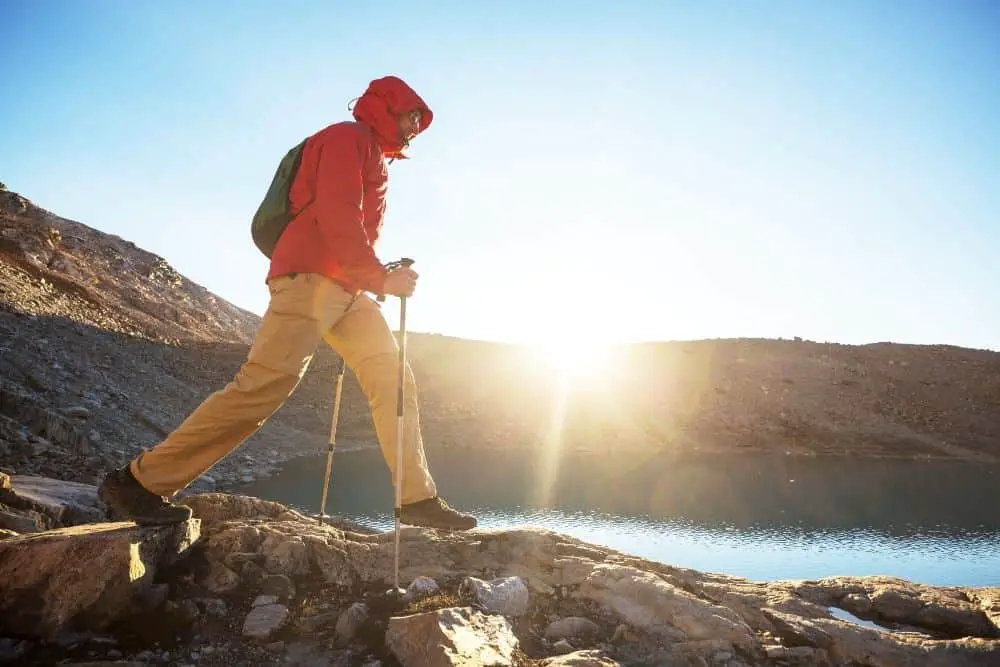
You do need hiking boots for hiking during summer. Of course, the weather will be hot, and you will be prone to sweating when on the trail, but do you still need hiking boots?
After all, hiking boots are sturdy, waterproof, and heavy. So yes, hiking boots have all those features, and they don’t stop you from enjoying hiking during summer.
Moreover, there are hiking boots that are suitable for summer hikes. For hiking during summer, you need hiking boots that are very breathable and are lightweight.
Yeah, of course, there are other outdoor shoes or footwear, like hiking sandals, trail runners, and others, that you can wear in place of hiking boots. But they may not be able to serve the purpose as hiking boots.
For one, hiking boots ensure you get the maximum ankle protection you need on the trail. In addition, hiking boots provide good traction that helps ensure that you don’t trip and fall on the trail.
Hiking boots are majorly designed to protect you irrespective of the terrain, so with hiking boots, you can hike on any terrain during summer. However, one major issue that could be a problem is breathability.
This is why you have the option of breathable, lightweight hiking boots suitable for summer. You need breathable ones because your feet need adequate airflow in your boots to prevent them from sweating.
They also need to be lightweight to reduce weight on your feet and prevent sweating, resulting in discomfort on the trail. When buying your hiking boots, you should go for ones made from mesh, synthetic, or a combination of these and leather.
Winter
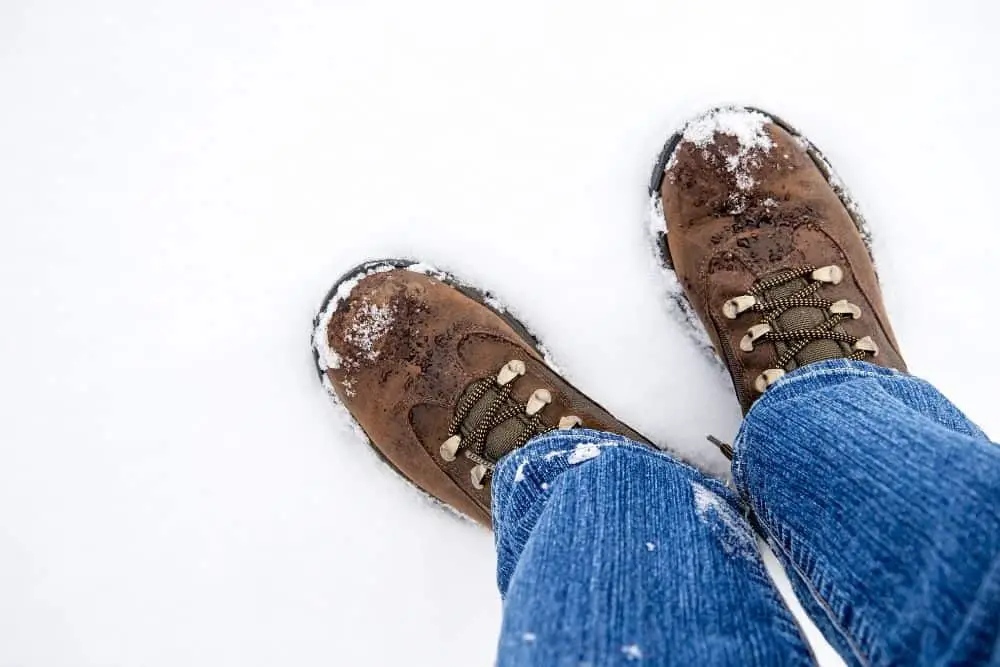
Winter is extremely cold and snowy, meaning that you need hiking gear that will keep you warm and protect you from falling on the trail. In addition, wearing the wrong footwear can expose your feet to coldness, resulting in cold feet.
Here, wearing hiking sandals or shoes may not protect your feet enough. When hiking during the winter, you should not hesitate to wear hiking boots.
Their tall uppers protect your feet and ankles from the cold. The hiking boot material also prevents cold from penetrating the boots and affecting your feet.
In addition, their soles ensure that your grip on the trail is solid and you are not prone to slipping. They are also waterproof, so you can be sure that moisture in any form can not penetrate your hiking boots when on the trail.
They also cushion your feet, so you are comfortable on the trail. Just like there are summer hiking boots, you can get one for winter. However, winter hiking boots are less breathable than summer hiking boots.
Full-grain leather hiking boots are less breathable than other leather types and mesh materials. They are also more waterproof than others. Apart from the material, manufacturers add waterproof membranes or coatings to hiking boots to enhance their waterproofness.
You should also wear hiking boots with thick insulation to ensure warmth on the trail. For these features, the hiking boots will be a bit bulkier and heavier than lightweight ones.
Spring
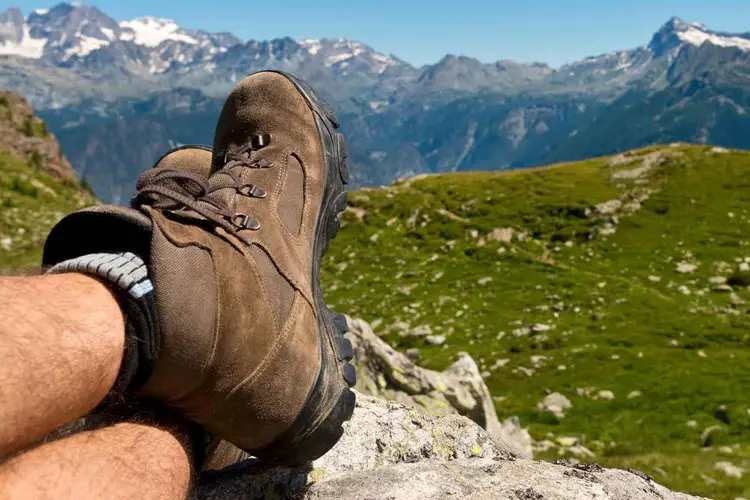
The weather in spring can be unpredictable. One minute, it can be brutally cold and windy; another moment, it can be super hot or rainy, sunny or snowy.
You could be walking over mud and puddles on the trail. Due to the weather being liable to change within a period, you need to check the weather forecast before setting out.
Even with that, you still need to be prepared for the trails. You need to prepare for snow, mud, ice, water, and more. Therefore, you need to wear hiking boots to hike during spring.
You need the warmth they provide from the cold during snow, rain, or wind. Hiking boots are also waterproof, and they keep moisture from soaking into your socks.
Their lugs also ensure that you don’t trip and fall when on the trail. When hiking during spring, you need waterproof hiking boots with good rubber soles like Vibram, which are good for comfort and traction.
They should be breathable so your feet can enjoy the cool air in your hiking boots.
Autumn
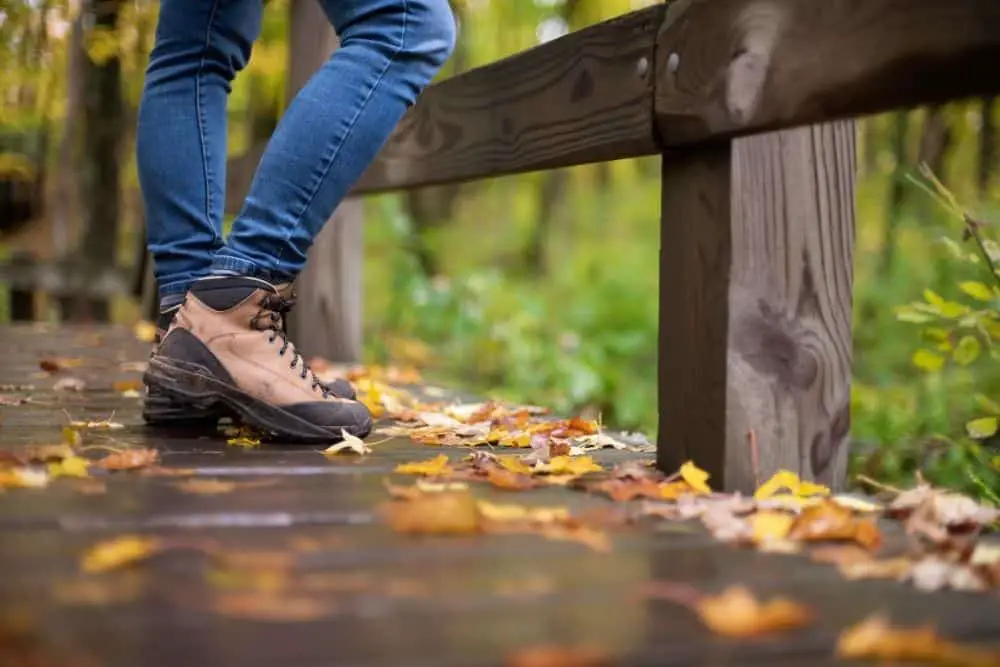
Autumn is not as cold or hot as winter and summer, respectively. However, just like spring, the weather can be unpredictable.
Nevertheless, the weather is usually cooler and more relaxing, so you probably don’t need that much insulation in hiking boots to keep you warm or very breathable hiking boots.
You need hiking boots for autumn hiking in the unpredictable weather. Waterproof hiking boots will come to your rescue if it happens to rain when you are on the trail.
Furthermore, they are breathable, so if it becomes a bit hot, they can help prevent your feet from sweating profusely on the trail.
Rain
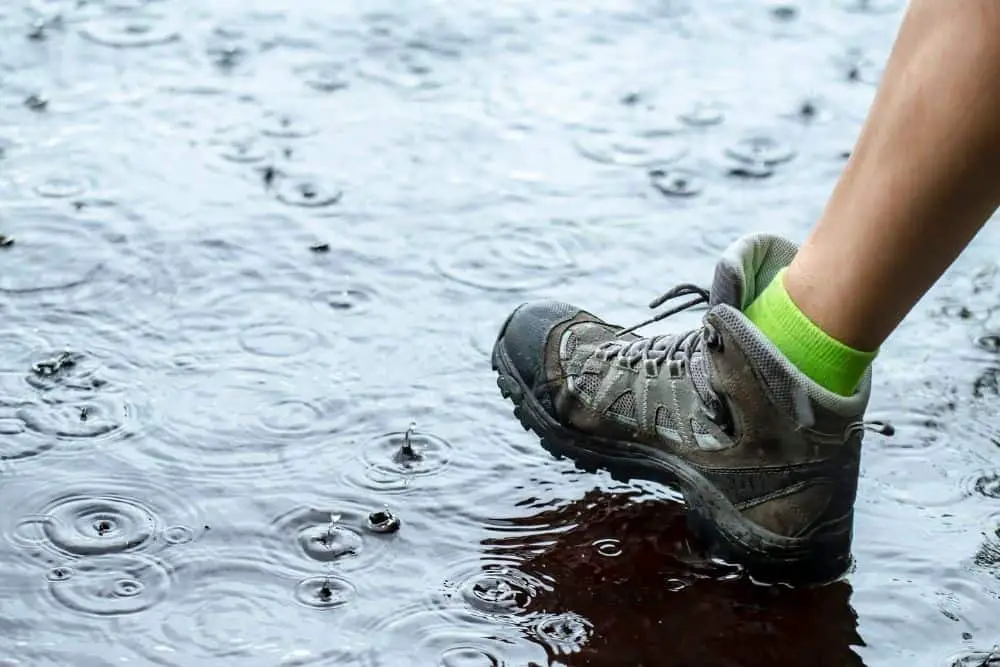
Hiking in the rain without appropriate gear is not really a pleasant sight to look at. Your feet won’t feel cold and wet on the trail.
And one thing about rain is that it can be unpredictable, and it may rain when you least expect it. Yeah, there are weather forecasts, and you should check and confirm them before you set out on the trail.
You don’t want to be unprepared for the rain. Moisture in your hiking boots can make you uncomfortable, cause blisters and other foot problems. In addition, regular shoes may not be able to protect your feet adequately on the trail during rain.
However, with waterproof hiking boots, you can ensure your feet’s protection when it rains. Hiking boots’ features like gusseted tongues, waterproof and tall uppers, and materials help ensure that your feet don’t get wet.
When it is raining, it is probable that the terrain will be slippery; hiking boots have good outsoles that prevent you from slipping on the trail. Therefore, to hike in the rain, you need waterproof hiking boots.
Based on purpose
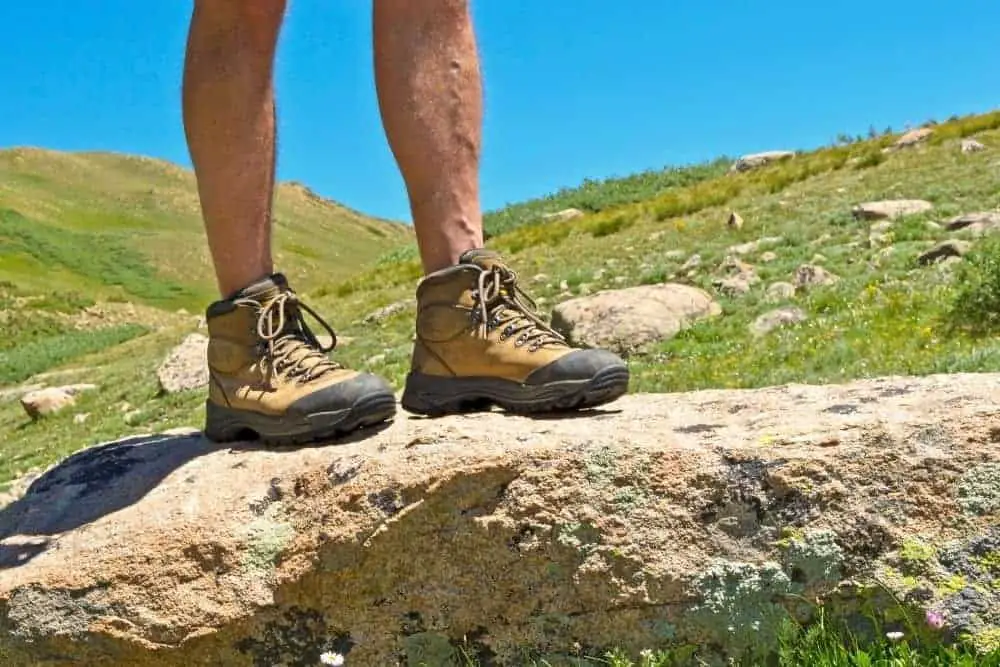
We all know that generally, people wear hiking boots for hiking. But apart from that, people use hiking boots for other purposes.
Does that mean that you can use hiking boots for almost anything? Absolutely not. Wearing hiking boots to a public function would look weird because they may not be suitable for the occasion.
Apart from hiking, people wear hiking boots for work, snowboarding, hunting, walking, fashion, and many other purposes. Should you also use them for these purposes or not, and how can hiking boots benefit you when you use them for things other than hiking?
Hunting

Of course, there is gear suitable mainly for hunting, including footwear. Many hunters probably have their hunting boots, which may include hiking boots because they can work in place of hunting boots.
So, yeah, you can wear hiking boots if that is the only thing available for your hunting activity. What makes hiking boots suitable for hunting?
They are lightweight, tough, breathable, good for different terrains, waterproof, and so much more. In addition, they provide ankle support and protect your feet when you are hunting.
For hunting, you need hiking boots that are waterproof, have thick insulation, have a high-cut design, and have enough cushioning. The good thing is that hiking boots are very durable, so you can use them for hunting and hiking for a long time.
Hiking boots can be worn for hunting; in fact, they are quite comfortable for the activity.However, hiking boots can not completely replace hunting boots.
Of course, they have similar builds, but they are not the same. This doesn’t make hiking boots less functional for hunting; you just need to find the right one. When hunting boots are unavailable, there are several hiking boots you can use for hunting.
Snowboarding
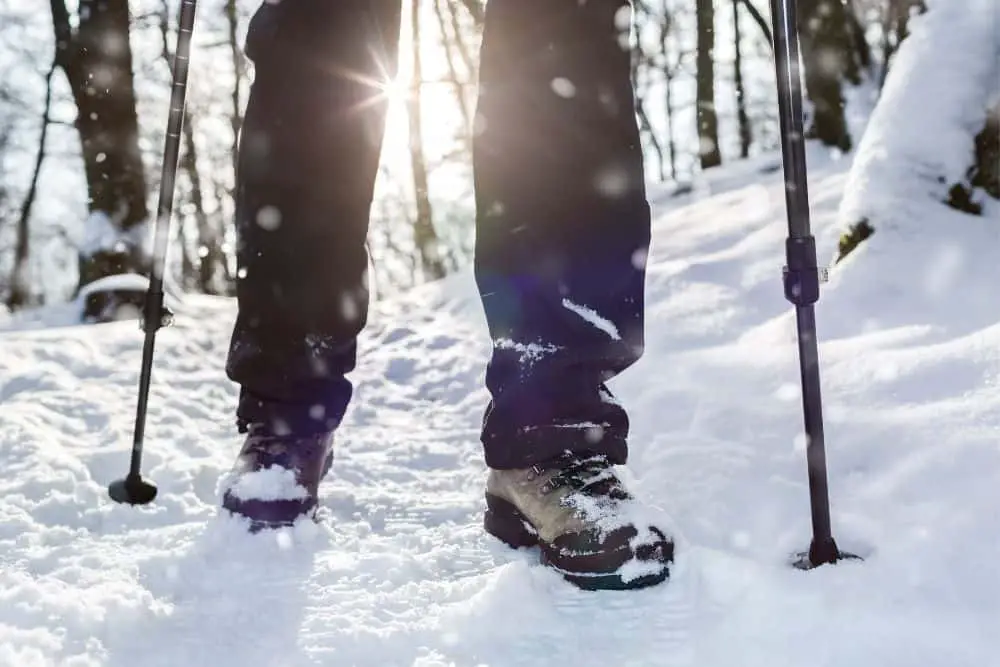
Hiking boots and snowboarding boots are not the same; they are designed for different uses. For an activity like snowboarding, you need stable shoes that provide enough support and are adequately insulated.
Even though they are not so similar, hiking boots have these features, so you can use them as a substitute if you don’t have snowboarding boots. In addition, hiking boots provide support for your ankles, toes, and heels when snowboarding.
They also have waterproof uppers to prevent moisture, are highly insulated for warmth, and have non-slip outsoles to ensure your stability on the snowboard.
One major issue with wearing hiking boots for snowboarding is that they may not be adjustable to fit the board’s bindings. This can be an issue because this is necessary. However, some hiking boots have designs that can work well for snowboarding.
If you plan to wear hiking boots for snowboarding, you have to be sure that they are insulated, waterproof, have non-slip outsoles, and provide adequate support.
Walking
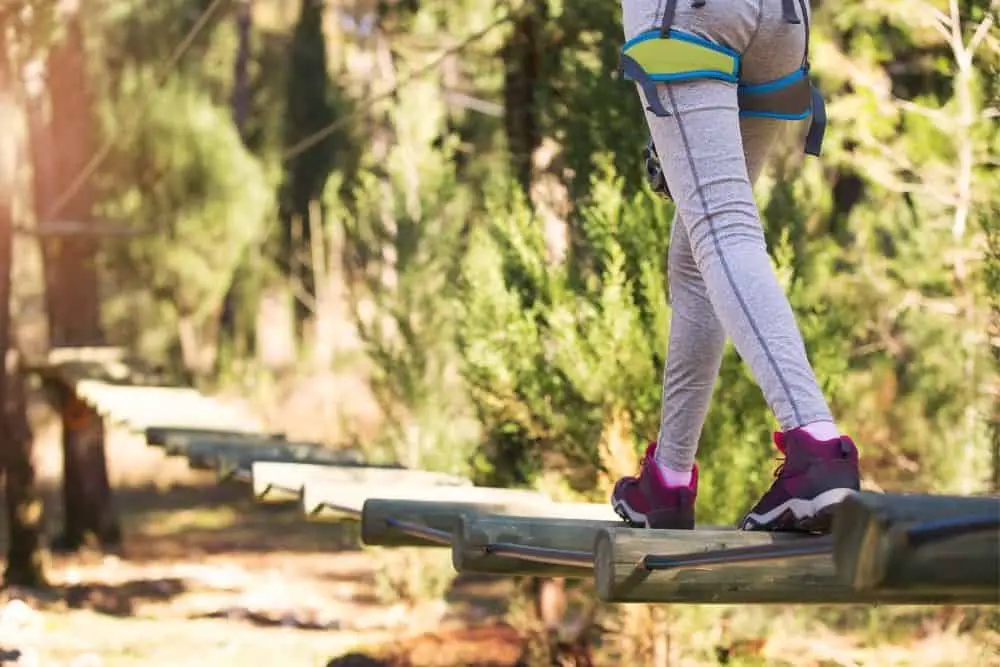
Walking is more relaxing than hiking; it’s less rigorous, stressful, and challenging than hiking. They are usually shorter than hikes.
Some people usually prefer to wear walking shoes, trail runners, etc., for walking. However, you can wear hiking boots for walking if you feel like it or if other options are not available.
You don’t necessarily have to wear your hiking boots for walking unless you are going for long walks and depending on the terrain as well.
But if you do decide to wear hiking boots for walking, you need lightweight materials that are breathable, waterproof, weather-adaptable, and supportive boots.
These are the things you should consider when selecting hiking boots for walking. However, choosing to walk with hiking boots depends solely on you.
Work
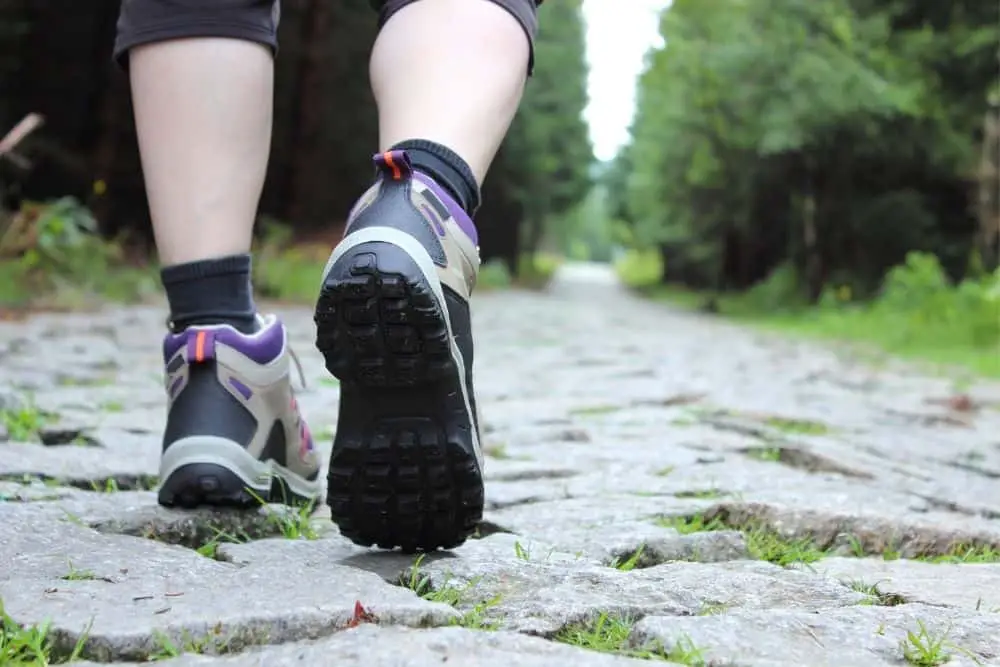
You can also wear your hiking boots to work, depending on the kind of job you do. Sometimes, people wear hiking boots in place of work boots because they serve similar functions.
When working, your feet and ankles need protection. You need boots that will protect you from falling, provide ankle support and shield you from external forces and work hazards.
Hiking boots also have features that are good for working. For instance, hiking boots provide adequate cushion and comfort for your feet when you wear them.
They are lightweight and won’t burden you when you are working and are breathable, so your feet don’t sweat and make you uncomfortable while you work.
If you need safety and comfort for work, then hiking boots can provide that for you. Therefore, hiking boots can work well in place of work boots if the latter are not available.
Wading
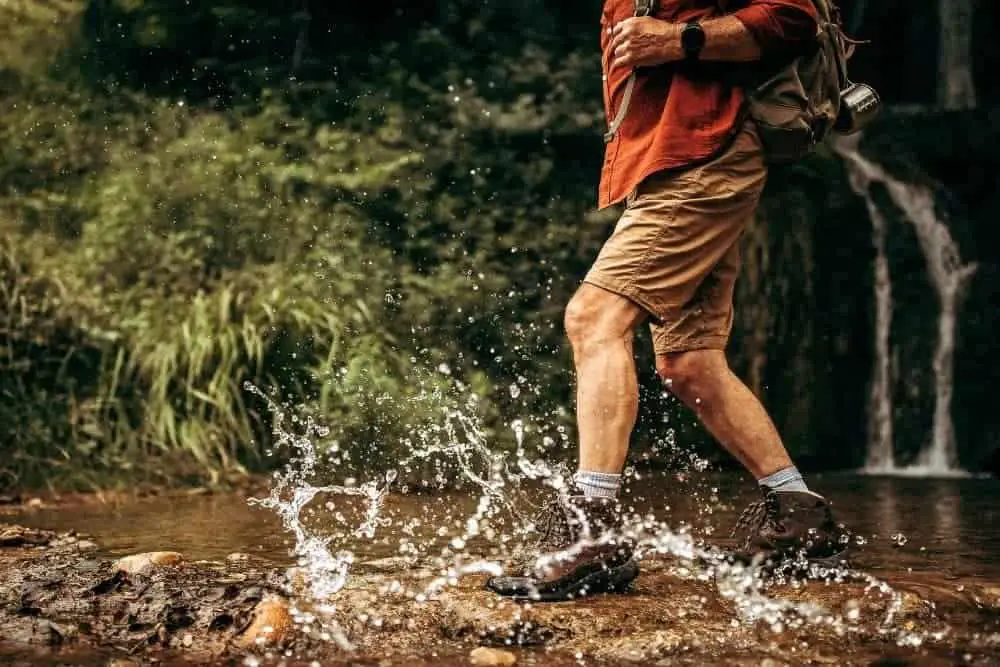
Hiking boots and wading boots have some similarities that make the former suitable for wading. When hiking, you will most likely have to wade through water, and your hiking boots will keep you safe.
Hiking boots usually have good traction that helps with good grip when in the water. This also helps prevent you from slipping and falling into the water as you walk.
More importantly, hiking boots are waterproof, so you can be sure to get a considerable amount of protection from water.
However, full-grain leather hiking boots may be unsuitable for wading because water would make them heavier and could ruin the materials faster.
Synthetic hiking boots with a waterproof membrane and other water-resistant features are more suitable for wading. Therefore, your hiking boots can serve the purpose of hiking and wading, and you may not necessarily need to have separate boots for both activities.
Day to day tasks
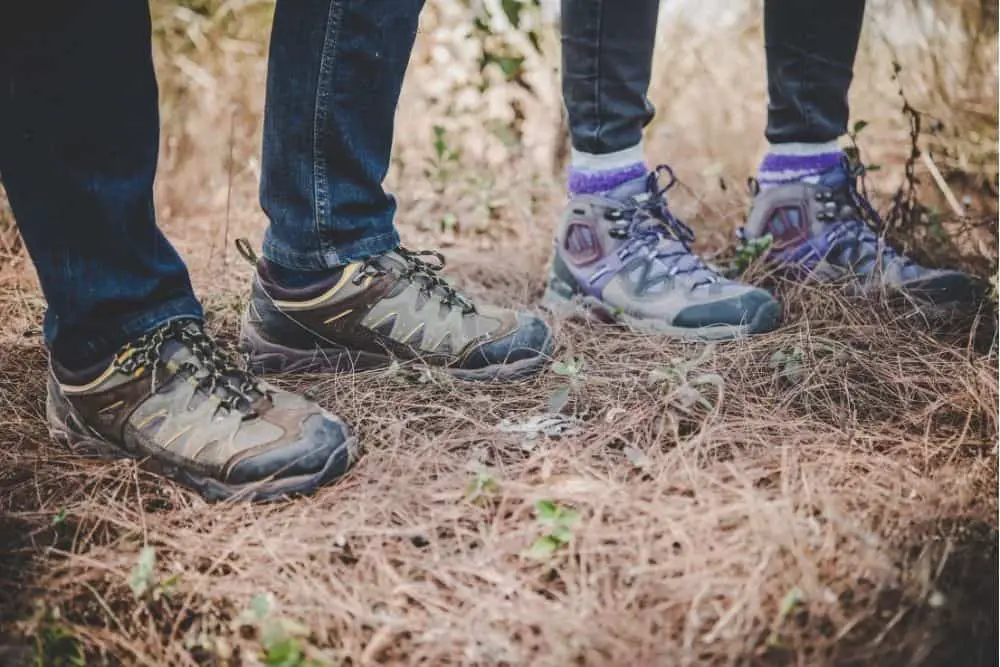
Another time to wear hiking boots is for day-to-day tasks around your home, like farming and gardening. But of course, you don’t need your expensive new hiking boots for this purpose, because they are far from hiking.
Moreover, using them every day for this purpose can affect their durability, which would defeat their original purpose. However, if you have old hiking boots lying around in your home, you can use them for these tasks.
Hiking boots are waterproof, breathable, safe, supportive, and protective for this purpose. They also provide good traction for working on different terrains.
You can repurpose your old hiking boots for these purposes, as long as they are comfortable to use.
Based on terrain
Manufacturers design hiking boots for use on different terrains. You can wear your hiking boots on different terrains, irrespective of how plain or rough they are.
What terrains should you wear hiking boots on?
Mud

Hiking on muddy terrain can be risky because the ground will be super slippery. Without the appropriate footwear, you can fall sliding down the trail, or worse, you could end up with injuries all over your body.
You can wear hiking boots to hike on muddy terrain, and you can be sure of safety and protection on the trail. First, hiking boots’ outsoles ensure that your grip on the terrain is strong, so you don’t slip and fall.
Second, hiking boots are waterproof, so the moisture from the mud cannot penetrate your hiking boots and make your feet messy. They also have insoles, tall uppers, and a cushion that ensures adequate ankle protection, so you don’t hurt your ankles when on the trail.
In addition, they have insulation that keeps your feet warm and shields them from the cold. One major disadvantage of wearing hiking boots in mud is that cleaning up afterward can be stressful due to the mud coating them.
But, generally, you can wear hiking boots in mud. You need waterproof, insulated, lightweight hiking boots for muddy terrain, so they don’t get too heavy and tire you when their outsoles are caked in mud.
Rock
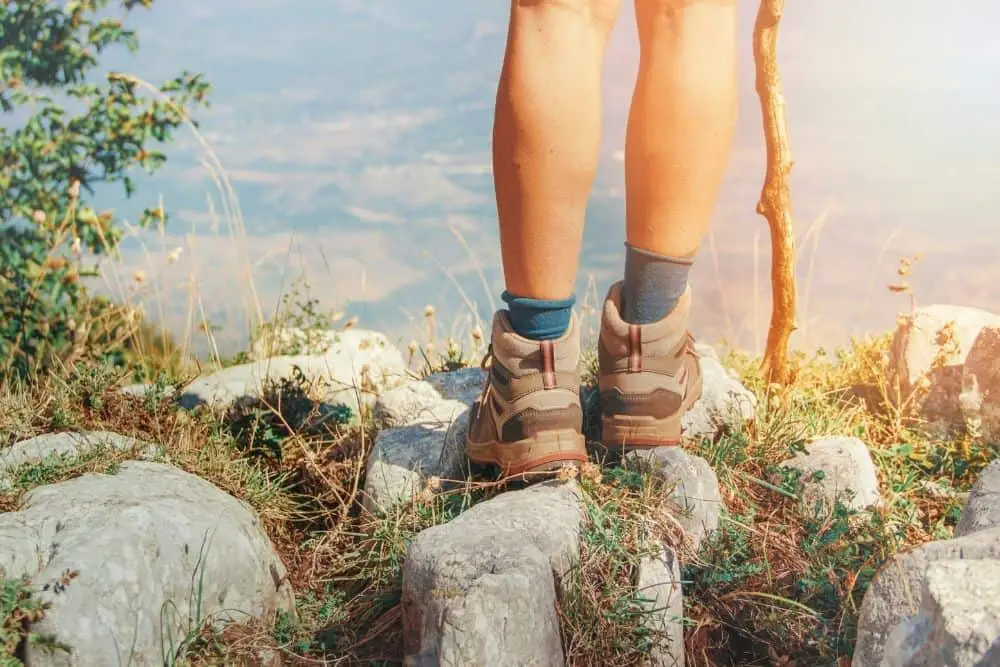
If you plan to hike on rocky terrain or go mountaineering, then you should wear hiking boots for your trip. You need to protect your toes, support your ankles, and ensure you have good grips on the trail so you don’t fall and break a bone or bruise your body on the trail.
You are likely to hit your leg on rocks, tiny or big, but thanks to hiking boots’ toe caps, you won’t feel the impact on your toes. Hiking boots’ outsoles also ensure good traction that prevents you from falling or slipping on the trail.
Hiking boots are durable and can withstand different elements and weather, so you can wear them for a long time without them falling apart. You need sturdy and rigid hiking boots for walking on rocky terrain.
They should also be breathable and waterproof to protect your feet from moisture on the trail and ensure maximum airflow in your boots.
Plain
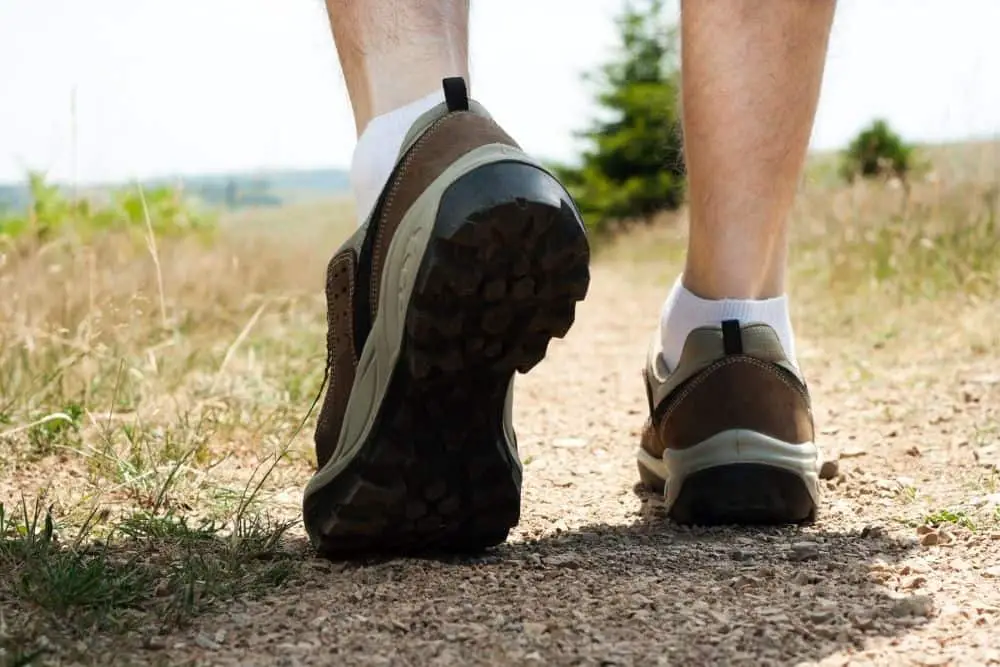
Hiking boots are also good for hiking on plain terrain with little or no obstacles. You could probably get away with wearing other shoes, but you may not be lucky every time.
Hiking boots protect you from feeling certain impacts on the trail. They also protect you from sand, stone, grime, dirt, and other grime that can make you feel uncomfortable in your shoes.
In addition, hiking boots have waterproof features that protect your feet from moisture on the trail, like rain, which you probably didn’t predict before setting out.
Hiking boots also support your ankles by carrying your weight for the duration of your hike, so you don’t feel much pain after your hike.
Depending on the weather, you can choose to go for summer or winter hiking boots that are lightweight for hiking on plain terrain.
Sand
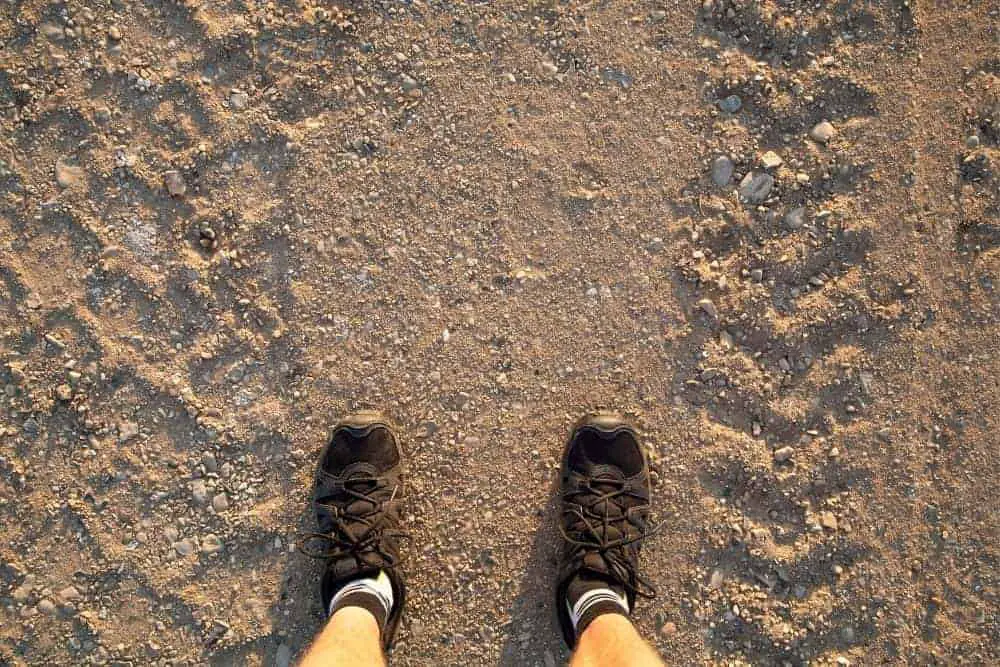
You need hiking boots to hike on sand or dunes. First, hiking boots have good traction that will help improve your grip on the trail, preventing you from falling and messing up your outfit with sand.
They also protect your feet from sand or tiny stones that can make you uncomfortable or cause blisters in your shoes. Second, they are breathable, ensuring that your feet enjoy cool air in your footwear.
The ankle support that hiking boots provide makes hiking in sand easier and less stressful. If you try hiking using hiking boots and other footwear, you will find that the former is more convenient and comfortable for hiking.
Heavy hiking boots can make you easily tired when walking on sand, so you need lightweight hiking boots that are breathable and waterproof.
Conclusion
The question of when to wear hiking boots has been going on for a while. People want to know if they need to wear hiking boots at all or if other footwear will do just fine.
As discussed in the article, you can wear hiking boots in different weather conditions and terrains for different purposes. The most important thing is to know which hiking boots are suitable for which weather, terrain, or purpose.
Lightweight or super breathable hiking boots are not suitable for all weather and terrain. For example, they are not suitable for winter hiking.
Likewise, bulky or heavy hiking boots won’t be good for hiking over mud. Therefore, you need to know which hiking boots will make you comfortable in whatever weather, terrain, or purpose you need them for.

